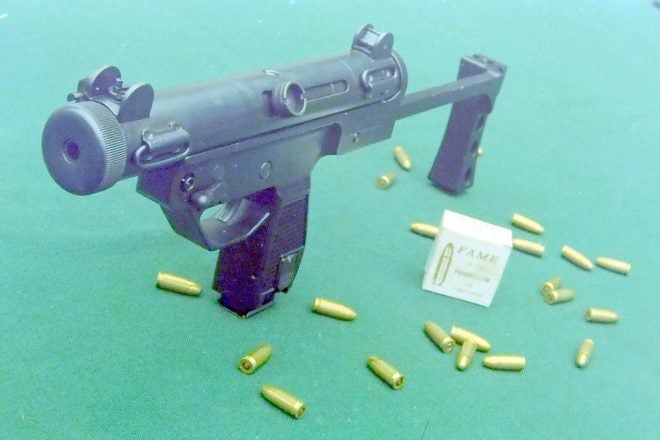A while ago, TFB posted (https://www.thefirearmblog.com/blog/2013/04/04/peruvian-mgp-87-grenade-launcher-submachine-gun/) a reprint of one of my articles for the 1995 Edition of Harris Publications’ SPECIAL WEAPONS for Military & Police, in which full description was given of the MGP family of 9x19mm submachine guns produced during the 1970s and 1980s by Peruvian Navy’s SIMA-CEFAR (Servicios Industriales de la Marina-Centro de Fabricación de Armas), located at the Callao Naval Base, near Lima. Those weapons remained in service for quite a while with that country’s Navy and National Police forces. The stockless MGP-79 and the subsequent MGP-79A and MGP-87 were no-frills designs of the so-called second-generation (post-WWII) subguns, with overall lengths in the 750mm region and loaded (32-round magazines) weights of 3.5kg or so.

First-ever published photo of the MGP submachine gun family designed and built in Peru by the local Navy’s SIMA-CEFAR organization in the 70s and 80s. A TFB exclusive!
In the mid-1980s, the Navy design guys came up with an entirely new approach in the form of another MGP (Marina de Guerra del Peru, Peruvian Navy) design, the “84”, originally called the MGP-15. The weapon entered series production in the late 80s, which apparently lasted for about seven years, but no precise information is available as to the number actually completed. The MGP-84 Mini was reportedly used for some time by some local special forces (SEAL-type units) as well as by some of Peru’s LE units in charge of VIP protection. Some export sales were reported to Argentina, Honduras, and Mexico. Apparently, the weapon is no longer in service anywhere. Okay, what was it like?

The MGP-84 Mini with the stock open and a 32-round magazine in place.
A first glance at the gun confirms that compactness was a primary design consideration, to such an extent that it seems to have no barrel at all: nothing protrudes from the front end cap of the cylindrical receiver. This is due to the use of a wrap-around (or telescopic) bolt which entirely surrounds the 166mm-long barrel, somewhat similar to what one finds inside an M1911 pistol. The return spring encircles the barrel.

The bolt/return spring/barrel assembly being removed from the cylindrical receiver.
Polymer material is used in the construction of the main body (pistol grip/magazine housing, trigger guard, and firing mechanism housing), to which the receiver is attached by two removable pins. The buttstock (steel arm, synthetic buttplate) can be neatly folded to the right of the gun, thus reducing overall length from 503mm to a mere 284mm. The compactness achieved allows the gun to be carried concealed under a jacket or coat (the manufacturer offered a custom-designed shoulder holster for that purpose) and quickly brought into action.

The Peruvian submachine gun compactness allowed it to be carried under a short jacket and quickly brought into action.
The staggered-row, two-position-feed magazines used with the small SMG are similar to, and interchangeable with, those of the Uzi family of 20- and 32-round capacity. Not surprisingly, the magazine release button occupies the same (low, left side) position on the pistol grip, and is a carbon copy of the Israeli gun’s, but nothing else relates the two designs. The pistol grip’s width (about 36mm) is reasonable to house the magazine employed, but not entirely comfortable for small-handed shooters such as the author’s. If the grip’s corners were made rounder, things would be better. Controls are conveniently sized and located. The fire selector, just above the forward end of the wide, very strong trigger guard, has the settings “S” (safety, blocking the bolt), forward; “1×1” (semi-auto), top; and “A” (automatic), rear. Its intended manipulation is with the thumb of the left hand, which is done in a quick, positive manner. The cocking knob, at about 45 degrees to the left, is directly attached to, and reciprocates with, the bolt, while the ejection port is on the opposite side.

UZI-type magazine being inserted into the pistol grip. Note width of the trigger guard, the two sling attachment points, and the small cocking button.
In July, 1994, I was kindly allowed by SIMA-CEFAR to give the MGP-84 Mini a somewhat brief and informal – but still satisfactory – handling and firing session at an improvised Peruvian Navy range at the Callao Base. The official firing areas were, at the time, pretty busy with navy and marine personnel under training, so I was assigned a neighboring place with sand dunes where the only targets available were empty plastic soda bottles and wooden crates within a maximum usable range of 50 meters or so, pretty realistic, though, as far as buzzguns are concerned.
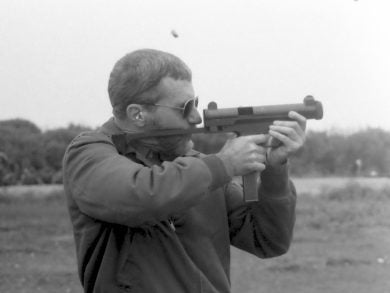
With a 32-round magazine in place, the MGP-84 Mini is seen here being fired in the semi-auto mode at the Callao Naval Base, near Lima, Peru. The relatively short buttstock still allowed adequate use of the sights (232mm radius).
Semi-automatic fire with the gun shouldered allowed consistent hits on the small crates at that maximum distance, with occasional misses, so the ability to do the same with human-sized targets was demonstrated. The gun’s weight with a full 32-round magazine is just under 3kg, which is more than enough to dampen the moderate recoil generated by the 9x19mm ammunition, while the protected sights (rear U-notch, front post, 232mm radius) allow quick, clear target acquisition. At shorter ranges (15-20 meters), aimed shots were able to always blow empty bottles to pieces, so a closer-range head shot in an emergency scenario (say, hostage life saving) would not be entirely impossible, if no other alternative available. Or am I watching too many action movies?
Similar-sized submachine guns generally have very high cyclic rates of fire, more often than not in the 1,000 rounds per minute range. When the Peruvians told me that their baby fired at about 650-700 rpm, I was still skeptical when I switched the selector to “A” and went ahead to face the crates and empty bottles. Instead of going directly to full rock-and-roll fun, I first tried single shots and very short (two or three rounds) controlled bursts first by means of trigger manipulation, which I found very easy to achieve with all the 32 rounds in the magazine. That done, the boxes of local (FAME – Fábrica de Municiones del Ejército)) and Brazilian (CBC/Magtech) ammo put at my service were mainly used in full-auto fire, long and short. I also played, both in semi- and full-auto, with the MGP-84 pistol-like with the buttstock folded and using the buttplate as a vertical support grip, which proved okay, although this practice degraded firing accuracy to some extent, no matter what Hollywood has led many people to believe. Single-handed fire, too? Sure, but to no very practical results.

When folded, the stock’s buttplate could be eventually used to fire the gun somewhat in a pistol-like fashion.
But the real fun in Callao came when I added the Mini’s dedicated sound suppressor. You just unscrew and remove the barrel retaining collar/front cap, which is replaced by the similarly-threaded silencing unit, the inner guts of which were inaccessible to me and not detailed by the guys there. What you actually add in length (I couldn’t find my notes!) and weight (neither!) to the subgun is irrelevant if compared to what your operational gains are. The tube’s performance at the range was also top grade, and the resulting noise levels (no dB meter available) were barely above the metallic sound of the bolt reciprocating. Firing stability/controllability, whatever you may call it, at full auto was actually enhanced by the added mass.
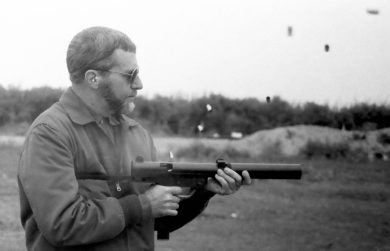
Suppressed and at full auto: the author’s favorite configuration for the MGP-84 during his hands-on experience back in 1994.
Basic take-down procedures: 1) remove two disassembly pins sideways; 2) separate receiver from main body; 3) unscrew and remove front cap; 4) pull out cocking knob from bolt; 5) slide out bolt/return spring/barrel assembly from receiver; 6) remove retainer and return spring from inside the bolt; 7) take barrel out of bolt.

No tools required for a quick field-stripping of the Peruvian subgun.
I was told that it was planned to offer a semi-auto Mini with the mandatory 16-in barrel for the U.S. market, while a semi-auto-only variant, designated MGP-84C (formerly, MGP-14), would be commercially available, too, for other areas allowing that. I believe it never happened. All in all, the “Marina de Guerra del Peru – 84” appeared at the time to have a promising future. However, for reasons unknown to me, it gradually faded away from view and has never again been heard of. Glad I had a chance to fire it. “Gracias, amigos de SIMA-CEFAR !”
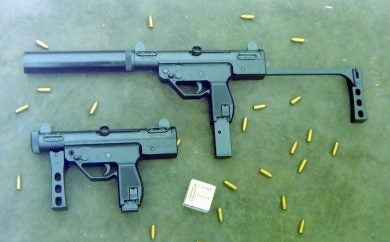
The MGP-84 in two possible configurations, 20- and 32-round magazines.
BASIC DATA: caliber: 9x19mm; operation: blowback, selective fire; feed: 20- and 32-round box magazines; weight, no magazine: 2.31kg; weight with loaded 32-round magazine: 2.9kg; length, butt extended: 503mm; length, butt folded: 284mm; barrel length: 166mm; barrel rifling: 12 micro-grooves, RH, 1:250mm; sights: rear U-notch, 100-200m; front post adjustable for elevation and windage; sight radius: 232mm; muzzle velocity: 410 m/s; cyclic rate of fire: 650-700 rounds/min.
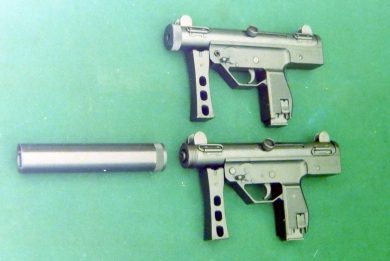
The dedicated sound suppressor replaced the barrel mounting nut.

This sound-suppressed, very close copy of the MGP-84 was seized in Colombia a couple of years ago. (Image source: Impro Guns)
 Your Privacy Choices
Your Privacy Choices
